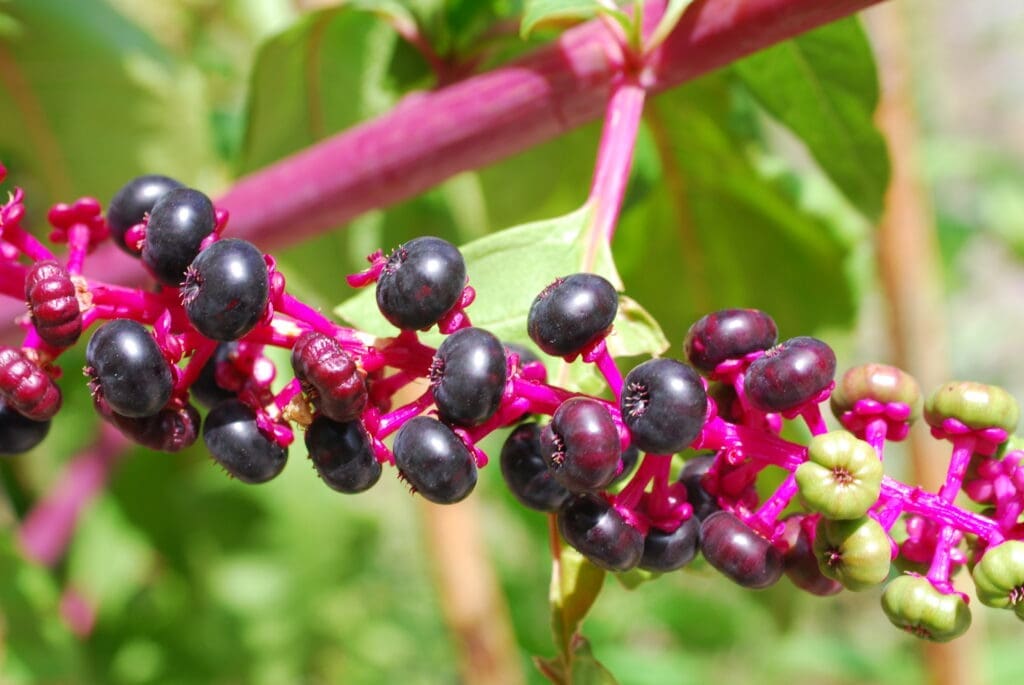
Phytolacca
Latin name: Phytolacca decandra
Short name: Phyt
Common name: Poke Root | Pokeweed | Red Ink Plant | Virginian Poke | Cancer Root
Primary miasm: Syphilitic Secondary miasm(s): Psoric
Kingdom: Plants
Family: Phytolaccaceae
- Symptomatology
- Remedy Information
- Differentiation & Application
A toxic perennial plant native to North America. All parts are poisonous, especially the root. Used by Native American tribes for inflammation, ulcers, and tumours. Its berries were historically used to colour wine and textiles.
Used externally in folk medicine for mastitis, breast tumours, and skin eruptions. Internally as a strong purgative and emetic (not safe in crude form).
Proved by Dr. Charles G. Raue and others in the 19th century; verified in Allen’s Encyclopaedia and Hering’s Guiding Symptoms
- Glands – especially mammary glands, cervical glands, tonsils
- Throat – tonsillitis, pharyngitis, ulcerations
- Muscles and fibrous tissue – soreness, aching, lameness
- Breasts – mastitis, induration, nodules
- Bones – periosteal pain, especially long bones
- Mouth and gums – ulceration, bleeding
- Skin – eruptions, ulcers, secondary syphilis
- Cold applications (especially to breasts or throat)
- Lying on the abdomen (for abdominal or breast pain)
- Discharge of pus or blood
- Motion (initially relieves rheumatic pain)
- Open air
- Rest
- Cold, damp weather
- Touch, pressure (especially glands and breasts)
- Night
- During menses
- Nursing (severe pain radiating from nipple)
- Sudden motion or jarring
- Warmth (especially warmth of bed)
- Belladonna – Also red, hot, swollen glands, but with more heat and throbbing; Phytolacca has more aching and prostration
- Lac caninum – Alternating tonsillar pain, but more neurotic and emotional; Phytolacca is more toxic and ulcerative
- Hepar sulphuris – Also painful breasts or tonsils, but more suppurative, sensitive to cold air; Phytolacca prefers cold applications
- Mercurius – Ulcerative throat with salivation, but more night sweats and trembling
- Conium – Glandular indurations of breast, but slower, more passive; Phytolacca is more painful and inflamed
- Complementary: Mercurius, Belladonna
- Antidotes: Rhus tox, Nux vomica
- Follows well: Bryonia, Hepar sulph., Sulphur
- Precedes well: Calcarea fluor., Silicea
Phytolacca decandra is the remedy of toxic glandular inflammation and aching toxicity. Its core lies in radiating pain, ulceration, and glandular destruction, whether in the breasts, throat, or lymphatic system. It suits syphilitic, cancerous, or septic states, with profound aching, exhaustion, and ulcerative tendencies. The patient feels like a bruised mass—physically battered, mentally hopeless, and burdened by toxic stagnation. It is invaluable in mastitis, diphtheria, nodular tumours, and chronic syphilitic affections.
- Key remedy in mastitis: Shooting pain from nipple to back during nursing
- Tonsillitis or pharyngitis with pain extending to ears
- Consider in syphilitic ulcers or nodular growths
- Breast tumours with hardness and blue discoloration
- Aches like from overexertion or hard manual labour
Throat
- Pain radiates to ears when swallowing
- Tonsils swollen, ulcerated
- Dry, burning pain with dark patches
Breasts
- Pain radiating from nipple when nursing
- Mastitis with induration
- Breast tumours, hard, blue
Glands
- Swollen, painful cervical and axillary glands
- Induration, worse at night
- Glands hot, sensitive, worse touch
Generalities
- Soreness, bruised pain
- Worse cold damp weather
- Prostration with glandular complaints
Skin
- Ulcers with purple borders
- Burning, indolent eruptions
- Syphilitic pustules
C. Hering – Guiding Symptoms: Primary source for glandular and skin pathologies
T.F. Allen – Encyclopaedia of Pure Materia Medica: Core proving symptoms and toxicological data
William Boericke – Pocket Manual: Clinical focus on mastitis and pharyngeal conditions
John Henry Clarke – Dictionary of Practical Materia Medica: Emphasised ulceration, breast tumours, and deep glandular action
James Kent – Lectures on Homoeopathic Materia Medica: Overview of personality, ulcerative states, and cancerous potential
